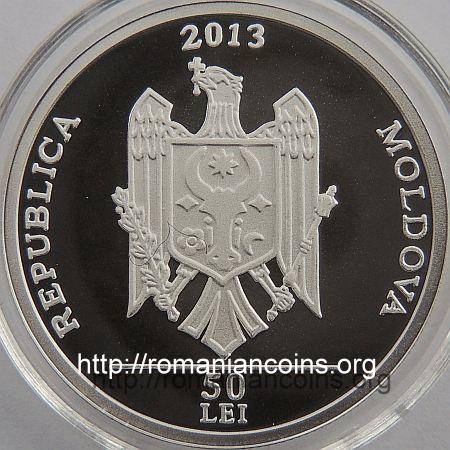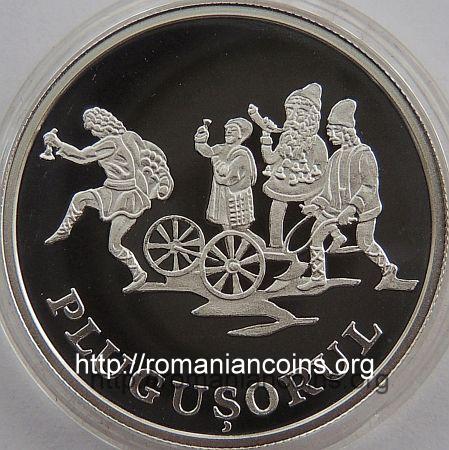
|
50 lei 2013 - Plugușorul - Holidays, culture, traditions series |
|

|

|
|
30 mm diameter, 16.5 g, 99.9% silver, grained edge year 2013, circular inscription REPUBLICA MOLDOVA meaning "REPUBLIC OF MOLDAVIA" and the coat of arms of the Republic of Moldavia, in exergue horizontal line and denomination "50 LEI" |
a flock of "urători" [orators] with a plough, inscription "PLUGUȘORUL" meaning "LITTLE PLOUGH"
Issuing date: 29th of November 2013 Mintage: 2000 coins |
The coin belongs to Holidays, culture, traditions series.
The Holidays, culture, traditions series is composed (until present, May 2017) the following 50 lei silver coins:
- pottery in 2007,
- cooperage in 2008,
- weaving in 2009,
- traditional musical instruments in 2010,
- carroling - colindul in 2011,
- Sînzienele,
- Miorița ballad in 2012,
- plugușorul [Little Plough] in 2013,
- mărțișorul in 2015,
- hora in 2016
In 2013 the series was enriched with a silver 100 lei coin: Guguță - literary character.
To the same series belongs a nickel plated brass coin - 10 lei 2003 - Celebration of the Wine.
About Plugușorul
Plugușorul means actually "little plough", a diminutive with definite enclitic article.
Plugușorul is a very old Romanian folk custom which occurs only once a year, in the eve of Saint Basil (New Year's Eve), being a ritual of summoning the fertility of earth. The custom today involves simulating ploughing and an oration, urătură (plural urături) in Romanian, which consists on reciting a versified composition named "plugușor [little plough]. Flocks of youngsters (mainly), wielding little bells, whips and "buhai" are wandering from house to house and wish in oration well, rich crop and long life.
Traditional "urături" of grown-ups meant actual wandering, in flocks of up to six or more orators, through the snowed village with plough (as depicted on the coin) and live oxen. One of the orators [urători] wears - as seen on the coin - a big bag to be filled with gifts from "the orated" [cei urați]: walnuts, apples, "colaci" [traditional loaves of festive bread].
The orator recites while being accompanied by the sound of little bells standing for the cattle bells. When the orator is commanding "mînați, măi [drive! (the oxen, cattle)] or "îndemnați, mă [urge! (the oxen, cattle)], the common whips and bullwhips start to crack as if oxen would be driven to pull the plough. The "buhai" also joins in. This is a, somehow musical, instrument imitating the roar of a buhai (buhai = bull). It is made out of a little barrel having one end closed by a membrane. In the middle of the membrane a strand of hair from horse's tail is attached "which, being dampened with water and pulled successively with one hand, then with the next and so on, produces a vibration resembling the roar of a distant bull" [1]. The next day in the morning - first day of new year's - another old Romanian, connected custom follows - Sowing or Sorcova.
There are an important number of plugușoare - little ploughs. A classic plugușor starts with
|
Aho, aho, children and brethren, Hold a bit and do not drive Near the oxen gather And listen to my word! and ends approximately so: We would even more orate Alas we fear of evenfall By your home Far from our home. [...] Abide in health, you, our host [...] Stop the plough you lads! Next year and many years! |
Aho, aho, copii și frați, Stați puțin și nu mînați Lîngă boi v-alăturați Și cuvîntul mi-ascultați! De urat am mai ura Dar ni-i c-om însera Pe la casa dumneavoastră Departe de casa noastră. [...] Rămîi gazdă sănătoasă [...] Opriți plugul măi flăcăi! La anul și la multi ani! |
All "plugușoare" start with "Aho, aho", interjection which is no longer in other use in Romanian language. This interjection is most likely akin with the Middle English interjection "hoy", which later sired "ahoy". "Hoy" was used to drive cattle, as mentioned in the epic poem Piers the Ploughman of 1393 by William Langland: "And holpen to erie þis half acre with 'hoy! troly! lolly!" which roughly translates to "And helped to plow this half acre with 'hoy! troly! lolly!'". Between main sections of "urătură", the flock of orators answer the "main sayer" with long "Hăăăăăăăăăăi, hăi!", reason for which urătură is also named hăitură.
Nowadays, in the cities, it is mainly the children who "go with plugușorul", orating especially at the relatives and neighbours and being mainly rewarded with money.
Alexe Mateevici, priest, poet, soldier but also ethnographer, wrote about this custom at the Basarabian Moldavians, in "Saint Basil - New Year in the customs of Basarabian Moldavians" [2]: "The New Year, before all, is the festivity of the Moldavian ploughman. This understanding is seen in all the customs occurring now. Because the ploughing always was and still is today the head and even only occupation of our Romanian, unmistakably the Moldavian gives it a very big signification." Also Mateevici stated the lay nature of the custom: "...the celebration of Saint Basil, the master of ploughmen, is entirely ploughman-based, peasant and not church originated.
Refrences
1. Marian, Simion Florea, Sărbătorile la români. Studiu etnografic. Editura Fundației Culturale Române, vol. I, București, 1898.
2. Mateevici, A., Sfîntul Vasile - Anul Nou în obiceiurile moldovenilor basarabeni. Wikisource, December 2013.
|
Back to selection page!
|